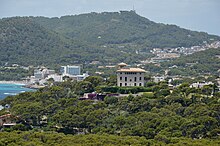Villa March
The Villa March , as the Palace Sa Torre Cega called, is a historic villa in Cala Rajada on the Spanish Mediterranean island of Mallorca .
It is located east of Cala Rajada on a hill above the town between the port of Cala Rajada in the east and Cala Gat in the west.
Architecture and history
The villa was built in 1911 on behalf of the entrepreneur Juan March . Other information cites the year 1911 as the date of acquisition of the property by March or the year of construction 1915 or the period from 1916. During the construction, the Sa Torre Cega ( German : Blinder Turm ) tower , which dates back to the 16th century, was included in the building. The designation as a blind tower is said to have resulted from the fact that the tower could not communicate with the network of watchtowers that spanned the island of Mallorca against pirate attacks, i.e. was blind to them. Juan March gave the villa to his wife Elionor Servera Mellis .
The ground floor of the villa was redesigned in a modern style. It is kept in blue and decorated with maritime elements. There are elaborate floor mosaics and wall paintings in the house.
The building is surrounded by an extensive park, the Jardines March , with a large variety of plants, trees and shrubs. The property covers an area of 60,000 m². After the death of his father, the son of the builder Bartolomé March had the park redesigned by the garden architect Russell Page . More than 40 sculptures by famous 20th century artists, including Manuel Alberdi , Eduardo Chillida , Henry Moore , Francisco Otero Besteiro , Auguste Rodin and José María Sirvent, have been placed in the park .
The house went to the Bartolomé March Foundation, which opened the property to the public.
A storm in November 2001 caused damage to the park. Some works of art were relocated to Palau March in Palma de Mallorca . The park was then closed for a few years. However, it was then reopened in August 2010 when the royal couple was present and is now open to the public within fixed opening hours.
Villa March in literature
The German writer Karl Otten (1889–1963), who lived in Cala Rajada from 1933 to 1936, mentions the villa in several short stories, even if the place is called Pueblo instead of Cala Rajada . In the short story The Lighthouse it is mentioned as the castle of Gordo (the fat one, meant Juan March). In the short stories Juanito and Juanito II villa and park are mentioned. In the short stories, the dwarf Juanito lives in the park , who has el Gordo in his hand because he had become an eyewitness when el Gordo killed a rival.
literature
- Marga Font: Mallorca , Ed .: institut dèstudis baleàrics, 2015, ISBN 978-84-8478-638-2 , p. 137.
- Susanne Lipps, Oliver Breda: Mallorca , DuMont Reiseverlag Ostfildern 2007, ISBN 978-3-7701-7634-2 , p. 336 f.
- Thomas Schröder: Mallorca , Michael Müller Verlag, Erlangen 2014, ISBN 978-3-89953-870-0 , p. 216.
- Cala Ratjada Insider , magazine, issue 2, season 2016/17, p. 40.
Individual evidence
- ↑ Thomas Schröder, Mallorca , Michael Müller Verlag, Erlangen 2014, ISBN 978-3-89953-870-0 , p. 216
- ↑ Tanja Wahle, Stefan Wahle, Travel Guide Cala Ratjada (Mallorca) , Book on Demand, Norderstedt 2015, ISBN 978-3-7386-4758-7 , p. 7
- ↑ Susanne Lipps, Oliver Breda, Mallorca , DuMont Reiseverlag Ostfildern 2007, ISBN 978-3-7701-7634-2 , p. 336
- ↑ Cala Ratjada Insider , magazine, issue 2, season 2016/17, p. 40
- ↑ Ed .: Hartmut Siefeldt, Torre Cega / Villa March in Karl Otten, stories from Cala Ratjada , travel book publisher, Eutin 2013, ISBN 9-781493-715459 , p. 81
- ↑ Ed .: Hartmut Siefeldt, Torre Cega / Villa March in Karl Otten, stories from Cala Ratjada , travel book publisher, Eutin 2013, ISBN 9-781493-715459 , p. 81
- ↑ Ed .: Hartmut Siefeldt, Torre Cega / Villa March in Karl Otten, stories from Cala Ratjada , travel book publisher, Eutin 2013, ISBN 9-781493-715459 , p. 81
- ↑ Tanja Wahle, Stefan Wahle, Travel Guide Cala Ratjada (Mallorca) , Book on Demand, Norderstedt 2015, ISBN 978-3-7386-4758-7 , p. 7
- ^ Karl Otten, Der Leuchtturm , Juanito and Juanito II in stories from Cala Ratjada , Travel Book Verlag, Eutin 2013, ISBN 9-781493-715459 , pp. 25 ff, 43 ff. And 49 ff.
Coordinates: 39 ° 42 ′ 44 " N , 3 ° 28 ′ 4.7" E



